
10 Classic American Motorcycles That Are Now Worth A Fortune
You’ll need a very understanding bank manager if you wish to own one of these classic American motorcycles
BY: HARRY FISHER COURTESY: TOPSPEED.COM
Classic motorcycles have been steadily increasing in value over the past twenty years, but while that means that there are still many classics that are affordable, it has also means that the collector market has gone through the roof, especially for classic American motorcycles. What sets these apart is that many of them were built in tiny numbers compared to, for example, Japanese motorcycles and many of the names that fill lists such as this disappeared in the early 1930s, as the Great Depression hit and closed almost all but two manufacturers, further increasing the rarity value. So, if you want one of these motorcycles in your garage, then you’re going to have to dig deep.
10 Harley-Davidson Strap Tank
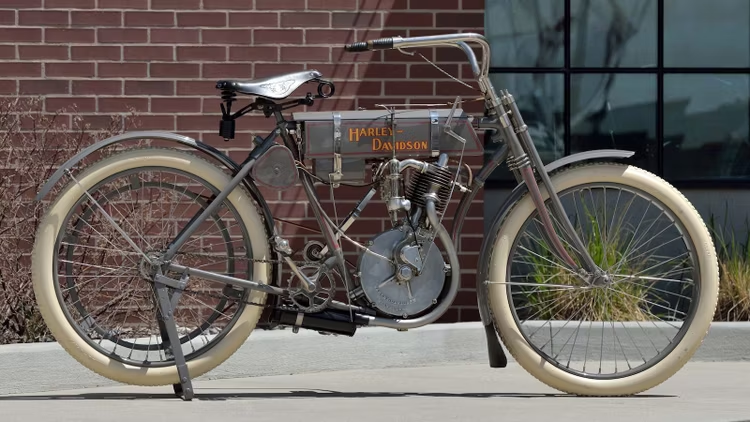
The second-oldest American motorcycle manufacturer still in production (the oldest in continuous production), Harley-Davidsons could fill every spot in this list if we go by auction sales. As with many names from the dawn of motorcycling in the U.S., early Harley-Davidsons were built in tiny numbers, before mass production became a reality and, given that 120 years have passed between the start of the company and today, it’s not surprising that so few have survived intact, nor that they fetch such high prices. Top of the pile is the 1908 ‘Strap Tank’ model, powered by a single-cylinder engine, that fetched $935,000 at auction in 2023, making it the most expensive motorcycle ever sold, closely followed by a similar 1907 model that sold for $715,000 in 2022.
9 Crocker Small Tank
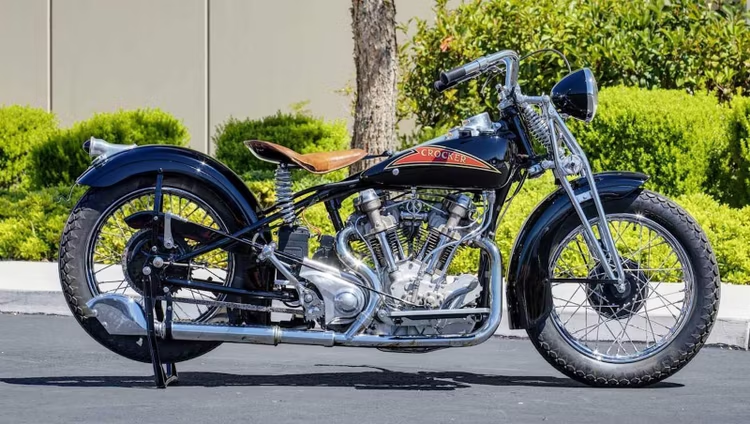
Nothing pushes up a motorcycle’s value more than rarity but if the Harley-Davidson ‘Strap Tank’ models mentioned above are rare because they are so old and so few were built, then a Crocker is perhaps even rarer because only around 100 examples were ever built, of which 70 are said to survive today. Built between 1932 and 1942, by which time America was firmly established in the Second World War and materials to build motorcycles were in short supply, causing Al Crocker to abandon motorcycle production, Crockers were powerful motorcycles, with V-Twin engines boasting up to 60 horsepower, when equivalent Harley and Indian V-Twin engines were producing around 40 horsepower. A 1939 ‘Big Tank’ Crocker recently sold for $704,000, while a ’Small Tank’ sold for $825,000.
8 Indian
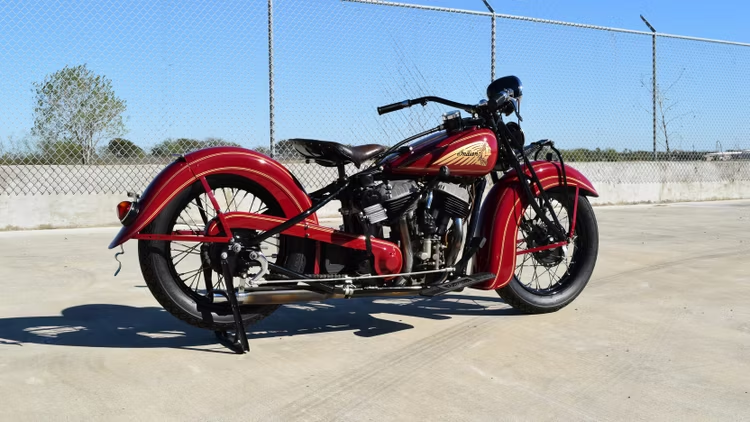
One of only two American motorcycle manufacturers to survive both the Great Depression and the Second World War, Indian subsequently had a very patchy existence between 1955, when the original company closed its doors, and 2011, when Polaris resurrected the brand as a viable American alternative to Harley-Davidson. Pre-war Indians are highly sought after and none more so than the four-cylinder models. In 1927, Indian acquired the rights to the ACE motorcycle name and designs, including the inline four-cylinder engine which was mounted longitudinally in the frame. The first fruits of this acquisition in 1928 were called Indian-ACE, but later models dropped the ‘ACE’ name and were simply badged as Indian 4. These were built up to 1942 and one sold recently for a reasonable (in this company!) $159,500.
7 Cyclone
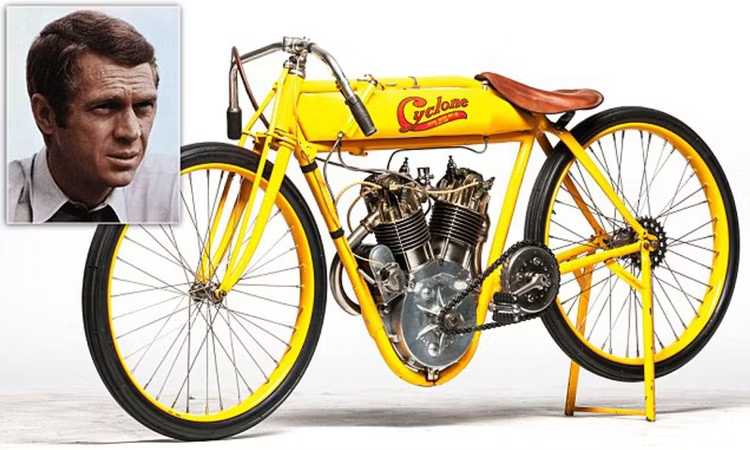
Another manufacturer whose influence is far in excess of its longevity. Cyclone was in existence for only five years (1912-1917) but made its mark with advanced engineering and domineering success on the board tracks of the day. The 999cc V-Twin engine featured overhead valves driven by shaft and bevel drive, while the crankshaft ran in roller bearings when most other manufacturers used plain bearings. The Cyclone engine produced an incredible (for the day) 45 horsepower and was capable of speeds in excess of 100mph, even if the crude lubrication technology of the day wasn’t able to keep up with such performance and the engines rarely lasted for more than 100 miles before needing a rebuild. An example owned by Steve McQueen sold for $825,000.
6 Flying Merkel

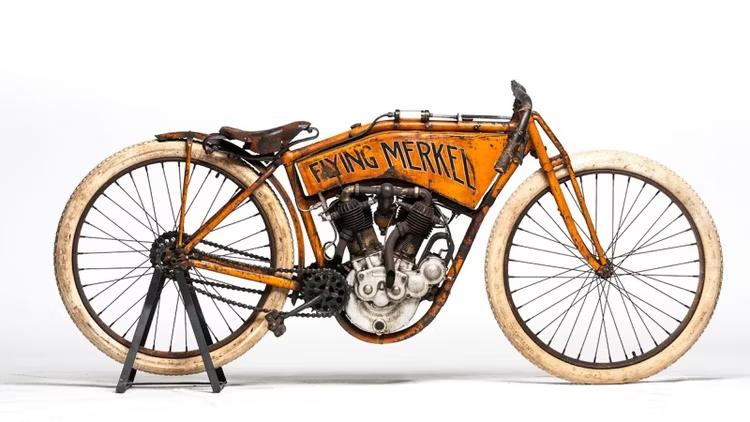
Thirteen years was all it took for the Flying Merkel name to cement itself in the history books and into the ‘must-have’ lists of any serious collector. Joe Merkel built his first motorcycle in 1903 and his motorcycles found fame and success on board tracks around the country as well as on the road. Finished in their distinctive orange color, Flying Merkels were beautifully made and featured technical innovations, such as the ‘truss fork’, a predecessor of the modern telescopic fork, and automatic oil feed to the engine, later adopted by Indian and Harley-Davidson. An original and unrestored 1911 Flying Merkel board track racer sold for $423,000 after sitting undisturbed for 70 years on the original owner’s property.
5 Henderson Four
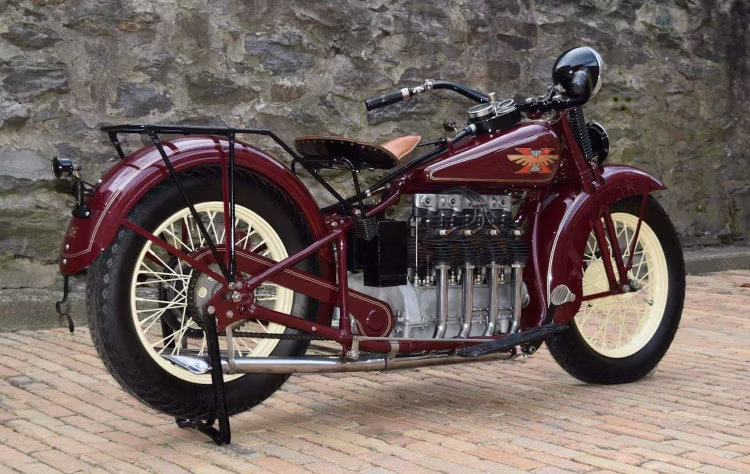
William Henderson was born into a pioneering motoring family, his grandfather having started the Winton Motor Carriage Company. William’s passion, however, was for motorcycles and his father encouraged him to pursue that line, so the first Henderson prototype motorcycle was manufactured in 1911. Right from the beginning, an inline four-cylinder engine of Henderson’s own design was used and, perhaps uniquely in American motorcycling manufacturer history, a Henderson was never powered by any other type of engine in the twenty-year history of the company. A 1912 Henderson Four with original paint sold in 2017 for $490,000.
4 Ace
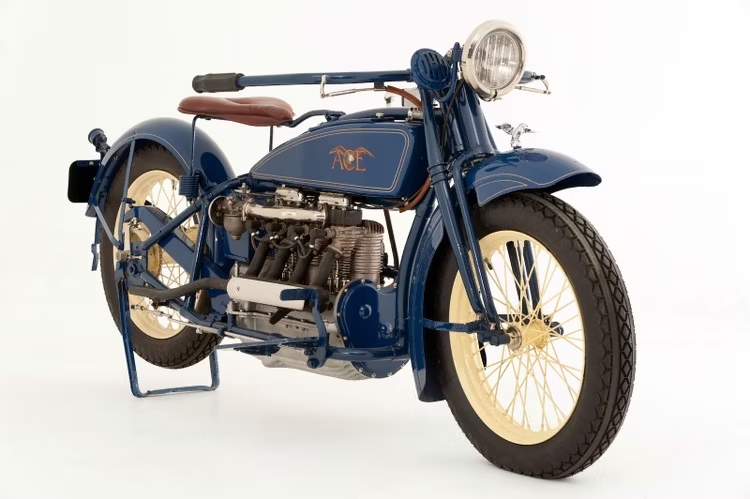
William Henderson sold the Henderson Motorcycle company to Ignaz Schwinn of Excelsior and started the Ace Motor Corporation in 1919, continuing to use a longitudinally-mounted inline four-cylinder engine. The Ace Four model had a 1,220cc engine producing 20 horsepower, but Henderson was killed testing an Ace Sporting Solo model in 1922 and the company ceased operations in 1924, being sold a couple more times before being purchased by Indian in 1927 (see above entry for Indian). Before that, however, an Ace XP-4 set a record speed of 129mph and the Ace Motor Corporation offered the Ace Speed Trophy and a cash prize to anyone who could break the record. Neither the trophy nor the cash were ever claimed. A 1922 Ace Sporting Solo recently sold for $198,000.
3 Pierce
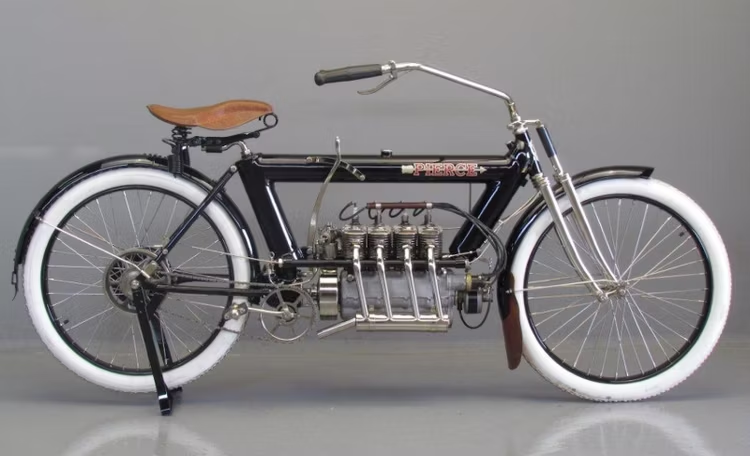
Percy Pierce was the son of the founder of the Pierce automobile company and, on a trip to Europe in 1908, bought himself a Belgian FN motorcycle, which was powered by an inline four-cylinder engine, the world’s first production four-cylinder motorcycle. The Pierce motorcycles was a close copy of the FN and became the first American four-cylinder motorcycle in 1909. It was a radical design, with the engine being used as a stressed member of the frame, which was made from large-diameter tubing: those tubes also acted as fuel and oil tanks. They were expensive motorcycles but even so, each motorcycle cost more to manufacture than its sale price and the company went bankrupt after fewer than 500 examples had been built. None have come up for auction recently but don’t expect much change from $200,000 if one ever does.
2 Iver Johnson

The Iver Johnson company manufactured firearms and bicycles between 1871 and 1993. However, for ten years between 1907 and 1917, the company also manufactured motorcycles. Iver Johnson advertised their motorcycles as ‘mechanical perfection’, a not entirely outrageous claim given a number of advanced design features such as dual crankshafts, nickel alloy machined parts and a hand-operated three-speed gearbox and even today, Iver Johnson motorcycles are regarded as some of the finest examples of motorcycle engineering of their time. In 2012, a 1915 Iver Johnson twin sold for $299,600 at auction.
1 Celebrity-Owned Harley-Davidsons

To end on, how about something completely different? Nothing increases the value of a motorcycle more than having a famous name among the owners, even if the motorcycle in question isn’t particularly rare or exceptional. A 1969 Harley-Davidson Electra Glide sold for $256,000 because it was once the property of Marlon Brando. Then there is the 1959 FLH Panhead that was given to Jerry Lee Lewis by Harley-Davidson in that same year. Harley gave one each to Lewis and Elvis Presley and Lewis owned his up to 2015 when it was auctioned for $358,000. Then for the ultimate one-owner Harley, how about the Super Dyno gifted by the company to the Pope!? Naturally, it wasn’t expected that the Pope himself would blast around the Vatican on it: rather, it was intended to be auctioned off for charity and eventually sold for an incredible $327,000, or $314,000 more than list price!
BY: HARRY FISHER COURTESY: TOPSPEED.COM